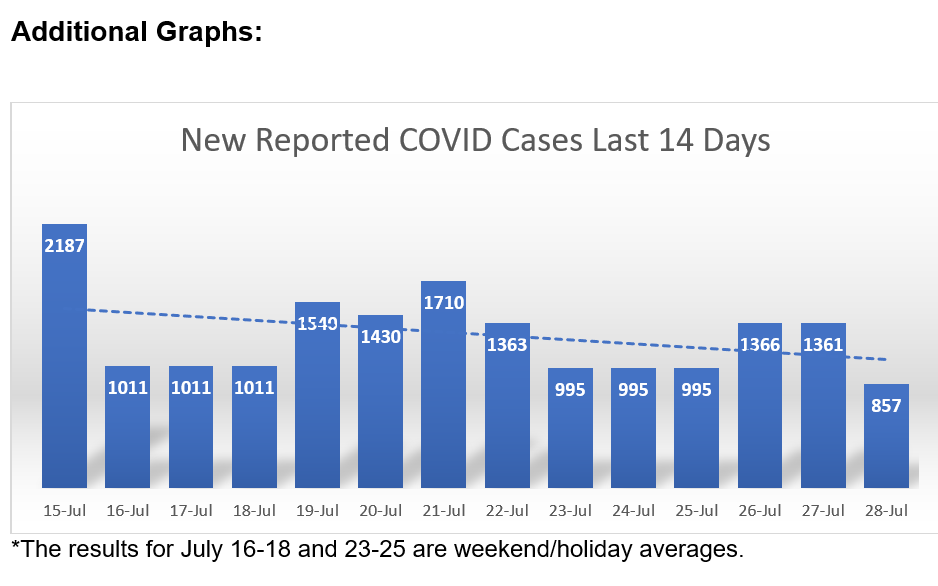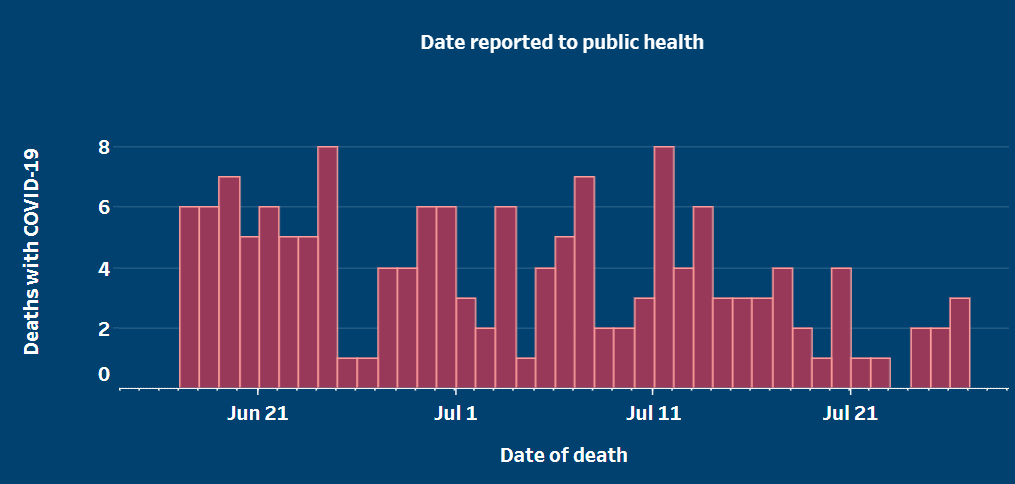|
August 1, 2022
Dear Neighbors and Friends,
I hope that you and your loved ones are doing well, staying healthy, and looking out for your neighbors and friends during this past week.
Sorry that this newsletter is coming a few days late. I’m in Denver at the moment, participating in a couple of national legislative organizations to which I belong: the National Conference of State Legislatures and the National Caucus of Environmental Legislators, which include a couple of national task forces that I’m on. The days are long and full of information (with little time left for the newsletter). I’ll report on some of the topics, deliberations, and shared information in the future.
But I did want you to provide you with the latest COVID news. Overall, the news for Oregon is good. We’re continuing to see the gradual decline in nearly all the COVID metrics that we were expecting.
More on all this in the various graphs, reports, and links in this week’s newsletter.
Also, you’ll find info about the next constituent coffee, just around the corner, along with the unfortunate news that we are indeed in wildfire season.
Until next time, please stay healthy and safe. And let me know if you have any questions or thoughts about anything in this week’s newsletter.
COMING ON SATURDAY: August Constituent Coffee!!!
This coming Saturday, August 6, is the first Saturday of the month, which means another monthly constituent coffee from 9 am to 10:30 am. We’ll be returning to Zoom for this meeting. (I’m alternating between in-person and remote for now.)
It will be a chance for me to report on what I’ve learned at NCSL and NCEL, on the various work groups that are underway, let you know about bills likely to come our way in 2023, and get your thoughts on priorities and future action.
You can register for the August 6 coffee here. Hope to see you there!
The First Big Fires Have Come to Southwest Oregon
In one of my previous newsletters I mentioned that we have been blessed with a late wildfire season this year. When I was down in Ashland/Medford two weeks ago for our Higher Ed Student Voice Task Force, I was able to enjoy smoke-free air there for the first time in years. However, while weather conditions in the winter and spring in this “La Nina” year have benefited the state as a whole, we’ve also known that Southwest Oregon remained vulnerable after years of drought conditions.
And that’s what has occurred.
This year’s first big fire is the McKinney Fire, which started in Northern California and is now heading to the Oregon border. You can read all about it in this article from the Associated Press. The Oregonian has an article about the close call experienced by my House colleague, Representative Dacia Grayber (herself a firefighter in her day job), who was out hiking in the area.
As a result of fire conditions and the potential approach of the McKinney Fire (which is currently 0% contained), Jackson and Josephine counties are now under Extreme Fire Risk Conditions. You can read more about it on the Department of Forestry blog.
ON THE COVID FRONT
Weekly Data Report:
Overall, infections, hospitalizations, and deaths have gone down in the last week, while test positivity has gone up slightly. We appear to be on the downslope of the “COVID Crest” for now.
- The number of reported infections has dropped significantly. OHA reported 7,932 new cases of COVID-19 during the week of July 15-21 (vs. 9,900 the week before), a 7-day average of 1,132 per day (vs 1,414 the previous week). The number of new cases is again likely an undercount, as many people are using home tests to determine their infection status but are not reporting those results.
- Average test positivity for the last week was 14.3%, a slight increase from the previous week’s 13.9%. Again, this number skews high because it likely reflects a higher proportion of people showing COVID symptoms (and thus going in for a test, rather than self-testing).
- On Thursday there were 400 COVID-19-related hospitalizations statewide, vs. 423 last Thursday. The number of hospitalizations appears to have peaked for now. Again, most of these hospitalizations are not in and of themselves due to COVID—they include those who tested positive after having been admitted for other reasons.
- Similarly, the number of COVID patients in Oregon’s ICUs was 43 on Thursday, slightly down from last week’s 45. These are the most serious COVID infections.
- There were 76 COVID-19-related deaths reported during the last week, vs. 99 last week. Again, many of these deaths actually occurred in earlier weeks but were just reported to the state.
OHA Biweekly Outbreak Report
Last Wednesday’s COVID-19 Biweekly Outbreak Report shows 223 active outbreaks (down slightly from 225 two weeks ago) in care facilities, senior living communities and congregate care living settings. There were 36 reported deaths during those two weeks (up from 19 the previous fortnight).
Weekly County Report: Big Drop in the Number of Counties at High Risk
According to the CDC Daily Counter (updated each Thursday), 11 (down from 21 last week) Oregon counties are now at high risk of COVID transmission, a status that reflects both the number of new COVID cases and the number of people in hospital for COVID: Baker, Clatsop, Jackson, Klamath, Lake, Malheur, Multnomah, Umatilla, Union, Wallowa, and Wasco.
Twenty-three Oregon counties (up from 16) have reported infection rates that place them in the Medium Risk category: Benton, Clackamas, Clatsop Columbia, Coos, Crook, Curry, Deschutes, Douglas, Gilliam, Grant, Harney, Hood River, Jefferson, Josephine, Lincoln, Lane, Linn, Morrow, Polk, Sherman, Tillamook, and Washington.
Five Oregon counties (up from 1)—Harney, Linn, Marion, Wheeler, and Yamhill—are now at Low Risk.
Again, we must remember that these are only the tests results that have been reported. With the prevalence of home tests, there are certainly many more positive cases out there that have not been reported.
We can also track the test positivity rates for each county at this dashboard. The test positivity rates reported this week show continued increases.
At 12.8%, Multnomah County shows an increase from last week’s 11.2%. Washington County is higher at 13.0%. Clackamas County is lower at 11.0%.

This Week’s Wastewater Monitoring Report Shows Continuing Stability in Oregon Cities
With testing reports giving us just a fraction of infections out there, wastewater monitoring has become a more reliable indicator of the amount of virus in cities around the state. That report is updated each week.
This week’s report shows us that two cities (up from 0 last week) are showing sustained increases. Those are Bend and Eugene.
Of the 40 cities monitored, 5% showed sustained increases, 16% showed sustained decreases, and 78% remained on a no-change plateau.
Additional COVID Updates and Links





Here again are some COVID resources that you will find useful:
If the above links are not providing you with answers to your questions or directing you to the help that you need, please consider me and my office to be a resource. We’ll do our best to assist you or steer you in the right direction.
Want to See Past Newsletters?
If there was COVID-related information in a past newsletter that you want to go back to, but find you’ve deleted it, you can always go to my legislative website (senatordembrow.com), click on “News and Information,” and you’ll find them all there. Also, if someone forwarded you this newsletter and you’d like to get it directly, you can sign up for it there.
Best,
 Senator Michael Dembrow
District 23
email: Sen.MichaelDembrow@oregonlegislature.gov
web: www.senatordembrow.com
phone: 503-281-0608
mail: 900 Court St NE, S-407, Salem, OR, 97301
|